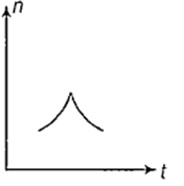 Multiple Choice Questions
Multiple Choice QuestionsA very large number of balls are thrown vertically upwards in quick successions in such a way that the next ball is thrown when the previous one is at the maximum height. If the maximum height is 5 m, the number of balls thrown per minute is (take g = 10 m/s2)
80
120
40
60
D.
60
A is the origin from where the ball is thrown.
Let u be the velocity of projection of ball.

∴ v2 = u2 − 2gh (upwards)
At B, v = 0
Ball is projected with 10 m/sec.
Time taken by ball to reach max height
v = u − gt
0 = 10 − 10t
⇒ t = 1 sec
In 1 sec, ball will reach the top and in next 1 sec it will reach the ground again.
∴ 1st ball reaches B in 1 sec.
IInd ball reached B in 1 sec.
When IInd is at B, 1st is at A and so on.
∴ Number of ball projected/sec = 1
Number of ball projected/min = 60
The resultant of two forces, one double the other in magnitude, is perpendicular to the smaller of the two forces. The angle between the two forces is
120°
60°
90°
150°
A projectile is moving at 20 ms-1 at its highest point, where it breaks into equal parts due to an internal explosion. One part moves vertically up at 30 ms-1 with respect to the ground. Then the other part will move at
20 ms-1
50 ms-1
30 ms-1
A body is projected vertically upwards from the surface of a planet of radius R with a velocity equal to half the escape velocity for that planet. The maximum height attained by the body is
R/2
R/3
R/5
R/4
From the top of a tower a stone is thrown up which reaches the ground in a time t1. A second stone thrown down with the same speed reaches the ground in a time t2. A third stone released from rest from the same between reaches the ground in a time t3. Then
The energy spectrum of a black body exhibits a maximum around a wavelength λ0. The temperature of the black body is now changed such that the energy is maximum around a wavelength . The power radiated by the black body will now increase by a factor of
64/27
256/81
4/3
16/9
n identical bulbs, each designated to draw a power P from a certain voltage supply. The total power which they will draw is
nP
P
A racing car moving towards a cliff, sounds its horn. The driver observes that the sound reflected from the cliff has a pitch one octave higher than the actual sound of the horn. If v is the velocity of sound, then the velocity of the car is
v/2
v/4
v/3
A railway engine whistling at a constant frequency moves with a constant speed. It goes past a stationary observer beside the railway track. Which of the following graphs best represent the variation of frequency of the sound n heard by the observer with the time t ?




The tension of a stretched string is increased by 69 %. In order to keep its frequency of vibration constant, its length must be increased by
30 %
20 %
69 %
